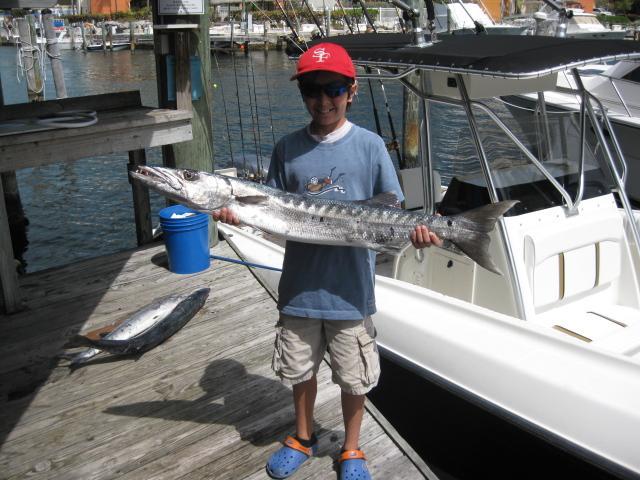Number of people sickened by toxin in barracuda and other tropical reef fish higher than previously reported
June 29, 2015

Public health records may significantly underestimate the number of people in Florida who are sickened by a rare dangerous food-borne toxin carried by popular sport fish, including barracuda, grouper and amberjack, according to a new study published online today in the American Journal of Tropical Medicine and Hygiene.
The analysis by researchers at the University of Florida’s Emerging Pathogens Institute and the Florida Department of Health found Florida’s annual incidence of poisoning with a toxin called ciguatera — which causes severe nausea, vomiting and, occasionally, neurological symptoms — is estimated at about 5.6 cases per 100,000 people. That is far more than the previous estimate of .2 cases per 100,000, derived from reports physicians submit to the Department of Health. This level of underreporting is consistent with that reported for other food-borne pathogens.
The findings reaffirm pre-existing warnings to avoid eating barracuda. But the data indicate that in Florida, grouper, amberjack, hogfish, snapper, mackerel and mahi mahi harvested in tropical and subtropical areas were also associated with illness.
“I think there is a broader awareness the farther south you go that barracuda are carriers but perhaps not as much awareness that a fish like grouper or amberjack can carry ciguatera,” said Elizabeth Radke, the lead author of the study. “I don’t think that people necessarily need to stop eating these other fish,” she added, “but they need to be aware there is a risk, and if they start feeling sick after eating, they should see a physician.”
Radke’s team found that most of the fish causing infections in Florida are caught in the Bahamas and the Florida Keys. Aside from these areas, about 5 percent came from waters in Palm Beach County and 4 percent came from Miami-Dade County.
The study found ciguatera poisonings in Florida are highest among Hispanics, possibly due to cultural preferences for consumption of barracuda, which has been shown to have a high risk of containing ciguatoxins. This suggests a need for continued targeted public health outreach and education on the risks from eating this type of fish.
According to state health records, each year ciguatera affects about one out of every 100,000 people in Miami-Dade and three out of every 100,000 in Monroe County, which runs south of Miami to Key West. But Radke and her colleagues found that while still rare, the actual number of illnesses was closer to 28 per 100,000 in Miami-Dade and 84 per 100,000 in Monroe.
The upward revision of estimated Florida infections was based on a survey of thousands of recreational saltwater anglers across the state, which revealed a large number of self-identified cases that had not been reported to the Department of Health. The scientists attributed the lower estimates derived from public health records to the fact that many people who get the disease don’t see a physician and many physicians who treat the patients poisoned by ciguatera either don’t report it to health authorities or don’t recognize it as an ailment distinct from other food-borne illnesses or common stomach viruses. However, it is also possible that some self-identified cases were suffering from other ailments. The Department of Health plans to increase awareness of ciguatera and the reporting requirements among physicians these coastal counties.
Radke said that while the study concludes ciguatera poisoning is more common in Florida than previously believed, researchers found no evidence that infections are on the rise.
A Common Toxin Passed Up the Food Chain
Ciguatera poisoning is the most common form of fish-related food poisoning in the world. The toxin is found in a type of algae that grow on coral reefs in warm tropical and subtropical ocean waters. It is initially transmitted to small fish that feed on reef vegetation. They then pass it along to larger fish that prey on them.
People who eat contaminated fish and ingest the toxin can experience symptoms of severe nausea and vomiting within one to three hours. In some instances it can lead to pain and tingling in the hands or feet and joint and muscle pain that can endure for months or even years.
There is no cure, though there is limited evidence that administering a drug called mannitol early in an infection can limit symptoms. Ciguatera is an especially resilient form of food poisoning as neither cooking nor freezing fish can destroy it. There is no test to detect ciguatera and no smell or discoloration in fish tissue to signal its presence.
Radke said there is concern that warming waters caused by climate variability could allow ciguatera to migrate north. But she said her team found no evidence of a northward expansion of ciguatera and that, in the eastern United States, the toxin appears to be mainly confined to the warmer waters of South Florida.
“There have been cases reported as far north as Georgia and South Carolina, but those likely involved fish that picked up the poison in South Florida or the Caribbean and migrated north,” Radke said. “But there needs to be continued surveillance at the toxin’s geographic borders.”
Christopher Plowe, president of the American Society of Tropical Medicine and Hygiene, said obtaining accurate estimates of disease burden is always difficult, “which is why it’s so important that these investigators dug deeper to get a better picture of ciguatera poisonings in Florida, We need to be vigilant for any increase in disease, as the spread of ciguatera could be particularly harmful to people who are more reliant on fish like barracuda and grouper for food and income.”
The Florida Department of Health recommends that people who have symptoms consistent with ciguatera poisoning after eating fish seek medical attention and save a fish remnant for possible testing. Additional information on ciguatera can be found on the department’s website, http://www.floridahealth.gov/environmental-health/aquatic-toxins/ciguatera-fish-poisoning.html.
